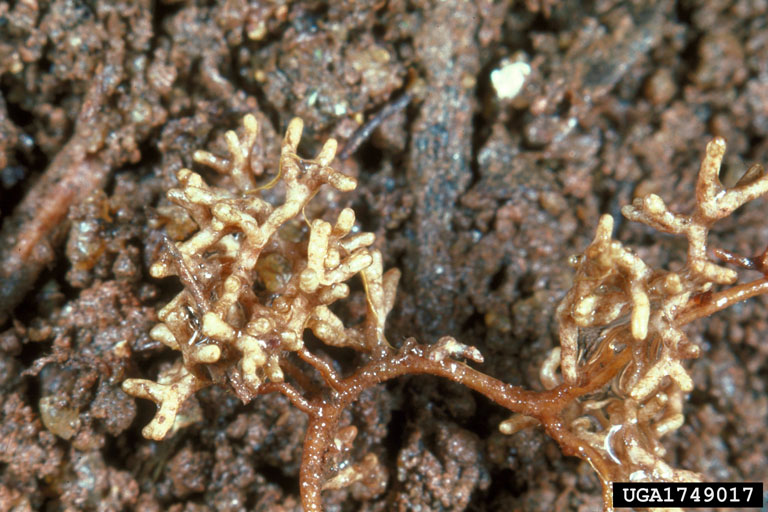 Mycorrhizae in the Landscape - November 12, 2012 Jeff Schalau, Agent, Agriculture & Natural Resources University of Arizona Cooperative Extension, Yavapai County Imagine a fungus that invades the roots of practically every plant in the landscape and uses the some of the plant's energy to sustain its cellular metabolic needs. This fungus is everywhere. In fact, they are probably lurking under the soil in your backyard right now. Is this another threat to life as we know it? No, it's real...it's mycorrhizae and it is actually very good for those “infected” plants. Mycorrhizae (pronounced mi-cor-ri-zay) form a mutualistic relationship with the green plants they colonize. In other words, both the fungus and the plant benefit from the association. In general, mycorrhizae assist the plant by improving water and mineral nutrient uptake. Tiny fungal strands called mycelia can grow through soil much faster and more easily than plant roots and can therefore utilize a much larger soil volume in search of these resources. In return, the plant provides carbohydrates (sugars) to the mycorrhizal fungus. About 80% of higher plants found in nature and all gymnosperms (cone bearing plants) can be colonized by mycorrhizae. There are two major classifications of mycorrhizae: ectomycorrhizae and endomycorrhizae. As the names imply, ectomycorrhiza refers to a fungus growing outside plant root cells. Endomycorrhiza refers to a fungus that penetrates plant root cells. Another name for endomycorrhizae is vesicular/arbuscular mycorrhizae (also called VAM). Soil inoculants that include various species of mycorrhizae are grown commercially and available for purchase. Mycorrhizal inoculum can be introduced to young plants during nursery production or applied to the soil prior to planting. There are certainly biological benefits to plants with mycorrhizal inoculation. One of the biological benefits is protection of plant roots from root rot fungi. The mycorrhizae occupy a niche that could otherwise be occupied by a disease causing pathogen. Mycorrhizae can also improve phosphorus uptake by the crop plant when phosphorus availability is low. How effective are these mycorrhizal inoculants being touted as “miracle” products for landscape plants? Many studies have been conducted and there is little evidence these mycorrhizal products will benefit plant growth and survival after planting in native soils. Current thinking is that within native plant communities, mycorrhizal populations have coevolved with plants species. Relatively undisturbed sites with native plant communities present or nearby would likely have functional mycorrhizal populations that would colonize roots of newly planted landscape plants. Washington State University Extension Horticulture Specialist, Linda Chalker-Scott, has conducted extensive literature reviews on the use of mycorrhizal inoculants in gardens and landscapes. Given current research results, she has identified two themes: 1. healthy soils naturally contain indigenous mycorrhizae and adding packaged mycorrhizae to such soils is a waste of money and resources; and 2. where soils are impaired to the point where indigenous mycorrhizal species can’t survive, mycorrhizal amendments alone won’t improve the situation. Dr. Chalker-Scott further concludes that beneficial microbes are important components of garden and landscape soils, and the best way to cultivate their presence is through thoughtful, sustainable horticultural practices. Sustainable practices include appropriate plant selection, appropriate use of organic mulches, adequate and timely irrigation, and minimizing fertilizer applications (especially phosphorus). The on-line version of this column includes diagrams and photos showing mycorrhizal associations and a link to an article on mycorrhizae by Dr. Linda Chalker-Scott. Aside from benefiting plants, many mycorrhizal fungi produce delicious edible mushrooms such as chanterelles, boletus, matsutakes, and morels. As you may imagine, mycorrhizal mushroom production is difficult to manage because it requires an entire ecosystem to produce them. For those that appreciate edible fungus, researchers continue to investigate forest management practices that produce both timber and wild edible mushrooms. Follow the Backyard Gardener on Twitter – use the link on the BYG website. If you have other gardening questions, call the Master Gardener help line in the Camp Verde office at 928-554-8999 Ext. 3 or e-mail us at cottonwoodmg@yahoo.com and be sure to include your name, address and phone number. Find past Backyard Gardener columns or provide feedback at the Backyard Gardener web site: http://cals.arizona.edu/yavapai/anr/hort/byg/.  Drawing showing the difference in mycorrhizal colonization by ectomycorrhizae and endomycorrhizae.  Photograph of ectomycorrhizae on conifer roots (Robert L. Anderson, USDA Forest Service, Bugwood.org). Additional Information Mycorrhizae: So, What the Heck Are They Anyway?, Dr. Linda Chalker-Scott, Washington State University Master Gardener Magazine, Fall 2009 https://s3.wp.wsu.edu/uploads/sites/403/2015/03/mycorrhizae.pdf |